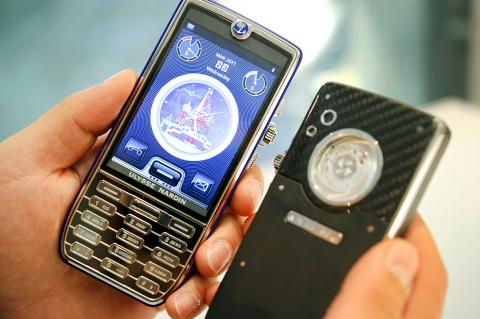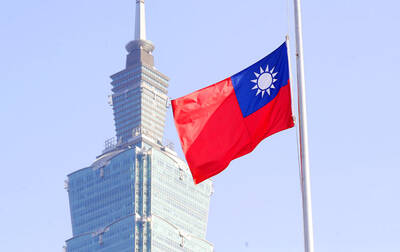With the younger generation opting to use their smartphones to tell time, the watch-making industry is being forced to get smart and high-tech to recapture consumers.
On show at the industry’s biggest watch and jewelery fair Baselworld this year are not only diamond-encrusted mechanical watches with complex movements, but an increasing number of timepieces that combine with the smartphone.
Some watchmakers unveiled luxury phones that incorporate mechanical watches, others were featuring watches with touchscreens. Japanese digital watchmaker Casio premiered watches that are able to communicate with smartphones.

Photo: AFP
“Many young people don’t wear watches anymore these days. They use their mobile phones to tell time,” said Fabrice Gonet, a designer from Slyde Watch SA.
Gonet and his business partners decided to create an electronic wristwatch with a touchscreen, which “lets people download photos, personalize their watch face,” although it does not have the telephone function.
“We thought of making this watch to recreate the link between horlogery and young people,” he said.
Asked if Apple could be a potential competitor, Gonet said that his company has taken out a patent for a virtual mechanic movement.
“The first thing we did was a feasibility study and we found that there was no patents for this. It was surprising, but it convinced us to go into it,” he added.
His company is not the only one tapping the smartphone market.
Ulysse Nardin, a Swiss luxury watchmaker, launched what it claimed is “the world’s first luxury hybrid smartphone,” integrating a mechanical watch rotor into the mobile phone.
The automatic rotor also creates energy to provide additional power to the phone.
Bobby Yampolsky, co-founder of UN Cells, who make the phones for Ulysse Nardin, admitted that it is insufficient to act as the sole power supply for the phone.
“If you wind it for four, five minutes you can make about a 30 second phone call or a few texts,” Yampolsky said.
Nevertheless, Yampolsky believes that such hybrid phones are the way forward.
“I feel this is the future. The watch world is over 300 years old. Cellphones are 30 years old. Before cellphones, watches were mobile technology. This is now mobile technology,” he said, holding up the phone, each of which costs between US$12,800 and US$130,000.
Mobile phones are “never going to take over completely, but it’s going to take up a huge part of the marketplace,” he added.
“The philosophy for us when we made this phone is, we asked ourselves, what do men have as a status symbol? We have our watches and we have our cars. This is basically the Ferrari that you can bring into a restaurant and put on the dining table,” Yampolsky said.
However, Casio, a long-term player in the watch industry that championed the quartz technology which almost brought about the demise of the mechanical watch, believes that there is still a place for the wristwatch.
This year, it introduced a watch that communicates with the mobile phone.
Casio’s managing director Hiroshi Nakamura explained that if the mobile phone rings during a meeting, a tap of the watch would stop the ringing.
Likewise, an e-mail arriving on a smartphone would also prompt a message on the wristwatch that a piece of mail has been received.
“You don’t always keep a mobile phone in your hands, you’ll put it in your bag. So it’s easier when you’re receiving a call to just tap on the watch,” Nakamura said.
“We don’t think that the iPhone will take the place of a watch. We see more possibilities for the watch,” he added.
“If you have a bluetooth watch and a smartphone then you don’t have to adjust the time when you’re traveling,” he said.
Casio’s latest watch will be available by the end of the year, with a launch due in the domestic market before broadening to other markets.

ELECTRONICS BOOST: A predicted surge in exports would likely be driven by ICT products, exports of which have soared 84.7 percent from a year earlier, DBS said DBS Bank Ltd (星展銀行) yesterday raised its GDP growth forecast for Taiwan this year to 4 percent from 3 percent, citing robust demand for artificial intelligence (AI)-related exports and accelerated shipment activity, which are expected to offset potential headwinds from US tariffs. “Our GDP growth forecast for 2025 is revised up to 4 percent from 3 percent to reflect front-loaded exports and strong AI demand,” Singapore-based DBS senior economist Ma Tieying (馬鐵英) said in an online briefing. Taiwan’s second-quarter performance beat expectations, with GDP growth likely surpassing 5 percent, driven by a 34.1 percent year-on-year increase in exports, Ma said, citing government

‘REMARKABLE SHOWING’: The economy likely grew 5 percent in the first half of the year, although it would likely taper off significantly, TIER economist Gordon Sun said The Taiwan Institute of Economic Research (TIER) yesterday raised Taiwan’s GDP growth forecast for this year to 3.02 percent, citing robust export-driven expansion in the first half that is likely to give way to a notable slowdown later in the year as the front-loading of global shipments fades. The revised projection marks an upward adjustment of 0.11 percentage points from April’s estimate, driven by a surge in exports and corporate inventory buildup ahead of possible US tariff hikes, TIER economist Gordon Sun (孫明德) told a news conference in Taipei. Taiwan’s economy likely grew more than 5 percent in the first six months

SMART MANUFACTURING: The company aims to have its production close to the market end, but attracting investment is still a challenge, the firm’s president said Delta Electronics Inc (台達電) yesterday said its long-term global production plan would stay unchanged amid geopolitical and tariff policy uncertainties, citing its diversified global deployment. With operations in Taiwan, Thailand, China, India, Europe and the US, Delta follows a “produce at the market end” strategy and bases its production on customer demand, with major site plans unchanged, Delta president Simon Chang (張訓海) said on the sidelines of a company event yesterday. Thailand would remain Delta’s second headquarters, as stated in its first-quarter earnings conference, with its plant there adopting a full smart manufacturing system, Chang said. Thailand is the firm’s second-largest overseas

SUPPLY RESILIENCE: The extra expense would be worth it, as the US firm is diversifying chip sourcing to avert disruptions similar to the one during the pandemic, the CEO said Advanced Micro Devices Inc (AMD) chief executive officer Lisa Su (蘇姿丰) on Wednesday said that the chips her company gets from supplier Taiwan Semiconductor Manufacturing Co (TSMC, 台積電) would cost more when they are produced in TSMC’s Arizona facilities. Compared with similar parts from factories in Taiwan, the US chips would be “more than 5 percent, but less than 20 percent” in terms of higher costs, she said at an artificial intelligence (AI) event in Washington. AMD expects its first chips from TSMC’s Arizona facilities by the end of the year, Su said. The extra expense is worth it, because the company is